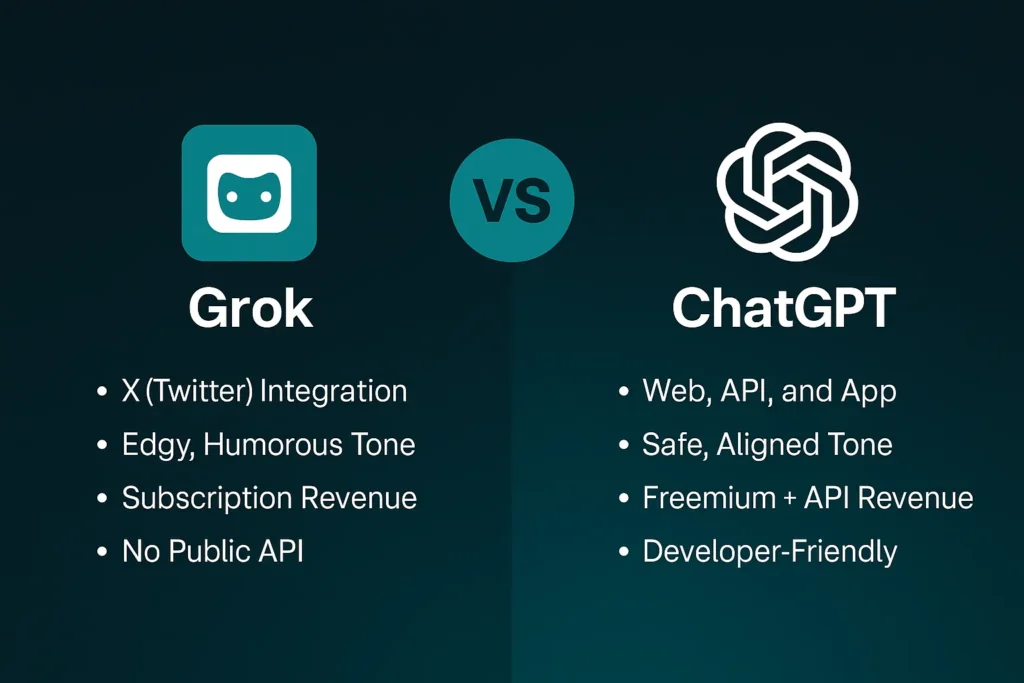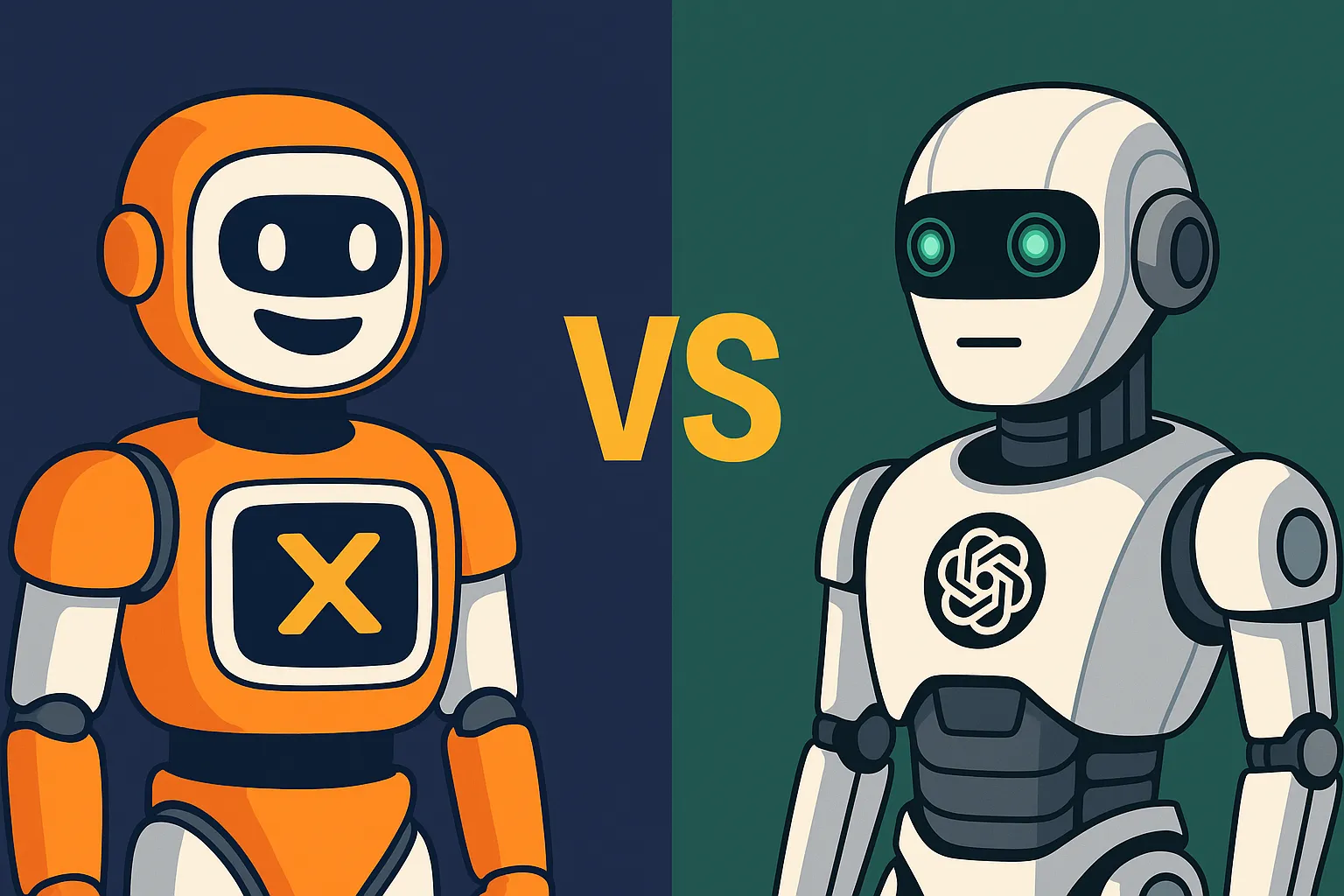In 2025, artificial intelligence is no longer a futuristic concept—it’s the core engine powering SaaS, productivity tools, content creation, customer service, and even social interactions. Among the leading players in the AI assistant landscape are Grok, developed by xAI (Elon Musk’s AI company), and ChatGPT, created by OpenAI.
Both platforms offer conversational AI models, yet their business models, monetization strategies, platform access, and partnerships differ significantly. For startup founders, app entrepreneurs, and AI innovators, choosing the right model to emulate can mean the difference between rapid adoption and missed opportunity.
This blog delivers a detailed, EEAT-compliant comparison of the Grok vs ChatGPT business models, including their revenue mechanisms, cost structures, partner ecosystems, and scalability approaches—so you can confidently build your own AI-driven platform in 2025.

What is Grok?
Grok is a conversational AI assistant developed by xAI, integrated primarily within X (formerly Twitter) and designed to offer real-time, edgy, and uncensored responses. Grok was powered by xAI’s proprietary LLM and marketed as an alternative to conventional, filtered chatbots.
Key Highlights:
- Developed by xAI, founded by Elon Musk
- Integrated into X Premium+ subscription
- Offers access to real-time X data (formerly Twitter API)
- Known for its humor, sarcasm, and minimal censorship
- Part of a broader Tesla / SpaceX / X tech ecosystem
What is ChatGPT?
ChatGPT is a generative AI chatbot by OpenAI, based on the GPT-4 family of large language models. ChatGPT powers millions of daily conversations across various platforms and is embedded in apps, websites, and enterprise systems globally.
Key Highlights:
- Available via ChatGPT app and API
- Free access to GPT-3.5; GPT-4 via ChatGPT Plus ($20/month)
- Powering tools like Microsoft Copilot and DALL·E
- Developer-friendly with extensive API usage and plugins
- Trained on broad datasets and aligned for safety
Business Model of Grok
Grok follows a platform-integrated subscription model, leveraging X’s social media presence and monetizing through premium user tiers.
Revenue Streams:
- X Premium+ Subscription: $16/month for access to Grok
- Enterprise Licensing (future potential)
- Ad Monetization Synergy: Users stay longer on X = more ad impressions
- Future APIs or integrations with Tesla/SpaceX tools (speculative)
Cost Structure:
- Model training and fine-tuning (on proprietary GPU clusters)
- Ongoing compute costs for inference
- Content moderation (minimal) and DevOps
- Integration and UX within X platform
- Limited public API = lower infrastructure complexity
Key Partners:
- X (social platform), Tesla (ecosystem), SpaceX (infrastructure)
- Payment processors for Premium+
- Internal xAI LLM and compute infrastructure
Growth Strategy:
- Upsell X Premium+ via AI exclusivity
- Brand positioning as an “uncensored” alternative
- Broaden integrations into Tesla dashboards, Starlink terminals, or Neuralink (future)
Learn More: Business Model of Grok : How This AI Chatbot Drives Revenue
Business Model of ChatGPT
ChatGPT operates under a freemium + API usage model, offering access to different tiers of AI models and monetizing through subscriptions, enterprise plans, and developer usage.
Revenue Streams:
- ChatGPT Plus: $20/month per user
- OpenAI API: Pay-per-token model for developers and startups
- Enterprise Plans: Custom pricing for companies
- ChatGPT Team & Business: Collaborative workspaces with AI agents
- Licensing (e.g., Microsoft Copilot): Strategic monetization partnerships
Cost Structure:
- Model training (e.g., GPT-4, GPT-4o) with massive compute infrastructure
- Hosting and inference costs via Azure/OpenAI superclusters
- Compliance, safety, moderation, and alignment tuning
- API scaling and developer support
- Global customer support and education
Key Partners:
- Microsoft: Cloud (Azure), product (Copilot), investment
- Developer ecosystems (Zapier, Slack, Discord integrations)
- Content providers and safety research labs
- Academic and enterprise partners
Growth Strategy:
- Expand multimodal AI access (image, audio, code, agents)
- Double down on enterprise adoption
- Roll out AI agents + memory capabilities
- Make ChatGPT the productivity hub of digital workers
Learn More: Business Model of ChatGPT : Features, Revenue, and Strategy
Comparison Table: Grok vs ChatGPT
| Feature | Grok (xAI) | ChatGPT (OpenAI) |
|---|---|---|
| Launched | 2023 | 2022 |
| Developer | xAI / Elon Musk | OpenAI |
| Model Access | X Premium+ ($16/month) | Free (GPT-3.5), $20/month (GPT-4) |
| Platform Integration | Embedded in X (Twitter) | Web, Mobile, API, Teams, Microsoft apps |
| Tone | Edgy, humorous, less filtered | Safe, aligned, professional |
| API Availability | Not public (as of 2025) | Fully public, developer-first |
| Use Cases | Social media, personal use | Enterprise, education, productivity, dev tools |
| Revenue Model | Subscription-based via X | Freemium + API + licensing |
| Partner Ecosystem | X, Tesla, SpaceX | Microsoft, Stripe, developers, SaaS builders |
Pros & Cons of Grok Model
Pros:
- Built-in user base via X
- Minimal content restrictions
- Brand leverage via Elon Musk ecosystem
- Efficient monetization through existing subscriptions
Cons:
- No standalone API or product
- Limited audience outside X platform
- Risk of misinformation without moderation
- Unclear long-term scalability strategy
Pros & Cons of ChatGPT Model
Pros:
- Enterprise-ready with APIs and agent infrastructure
- Wide availability across platforms
- Strong partner network (Microsoft, Zapier, Notion, etc.)
- Rapid innovation across modalities
Cons:
- High operational costs for compute
- Potential alignment criticism from extremes (too filtered)
- Complex tiering may confuse casual users
- Competitive pressure from open-source LLMs
Market Data: Growth, Revenue & Funding
| Metric | Grok (xAI) | ChatGPT (OpenAI) |
|---|---|---|
| Monthly Users | ~2M+ via X Premium+ (est.) | 180M+ ChatGPT users |
| Subscription Cost | $16/month | $20/month (GPT-4), API per usage |
| API Access | Not publicly available | Full OpenAI API access |
| Funding | Elon Musk-backed, internal | $13B+ raised, Microsoft major investor |
| Growth Rate | 30% QoQ since launch (est.) | Massive B2B expansion, 50% YoY API growth |
| Platform Usage | X platform exclusive | Multi-platform: web, apps, APIs, enterprise |
Which Model is Better for Startups in 2025?
Grok-style is ideal if you’re:
- Building an AI product inside an existing social or closed ecosystem
- Focused on entertainment, virality, and minimal moderation
- Monetizing via subscription tiers
ChatGPT-style is ideal if you’re:
- Creating a developer-first or enterprise-facing AI product
- Need API monetization and third-party integrations
- Building across productivity, SaaS, or support categories
Choose Grok-style if…
- You have a platform like a social network, forum, or niche app
- You want to build an edgy or viral AI personality
- You’re monetizing via membership access
Launch your social AI assistant with Miracuves’ Grok Clone
Choose ChatGPT-style if…
- You’re building a general-purpose AI product or dev platform
- You need extensive API access, user tiers, and custom agents
- You want to scale via B2B, B2C, and SaaS models
Build your AI powerhouse with Miracuves’ ChatGPT Clone
Conclusion
Whether you lean toward the bold innovation of Grok or the platform-rich extensibility of ChatGPT, Miracuves delivers white-label solutions that scale with your vision.
Our AI clones are built for performance, flexibility, and monetization, making it easier than ever to enter the conversational AI market in 2025 with confidence.
Let’s build your AI future. Talk to Miracuves today
FAQs
1. Is Grok available outside X (Twitter)?
Not yet. Grok is currently exclusive to X Premium+ users and not available via public API.
2. Which model is easier to monetize quickly?
Grok-style via subscription bundling; ChatGPT-style offers broader monetization but requires infrastructure.
3. Can I create an API around a Grok-like chatbot?
Yes, Miracuves can help you turn a Grok-style UX an API-ready AI product.
4. Which is better for enterprise adoption?
ChatGPT. It offers APIs, memory, collaboration, and compliance for business use.
5. Can I combine both models?
Absolutely. Hybrid models are gaining traction—a fun AI face with an enterprise back-end is a powerful mix.








